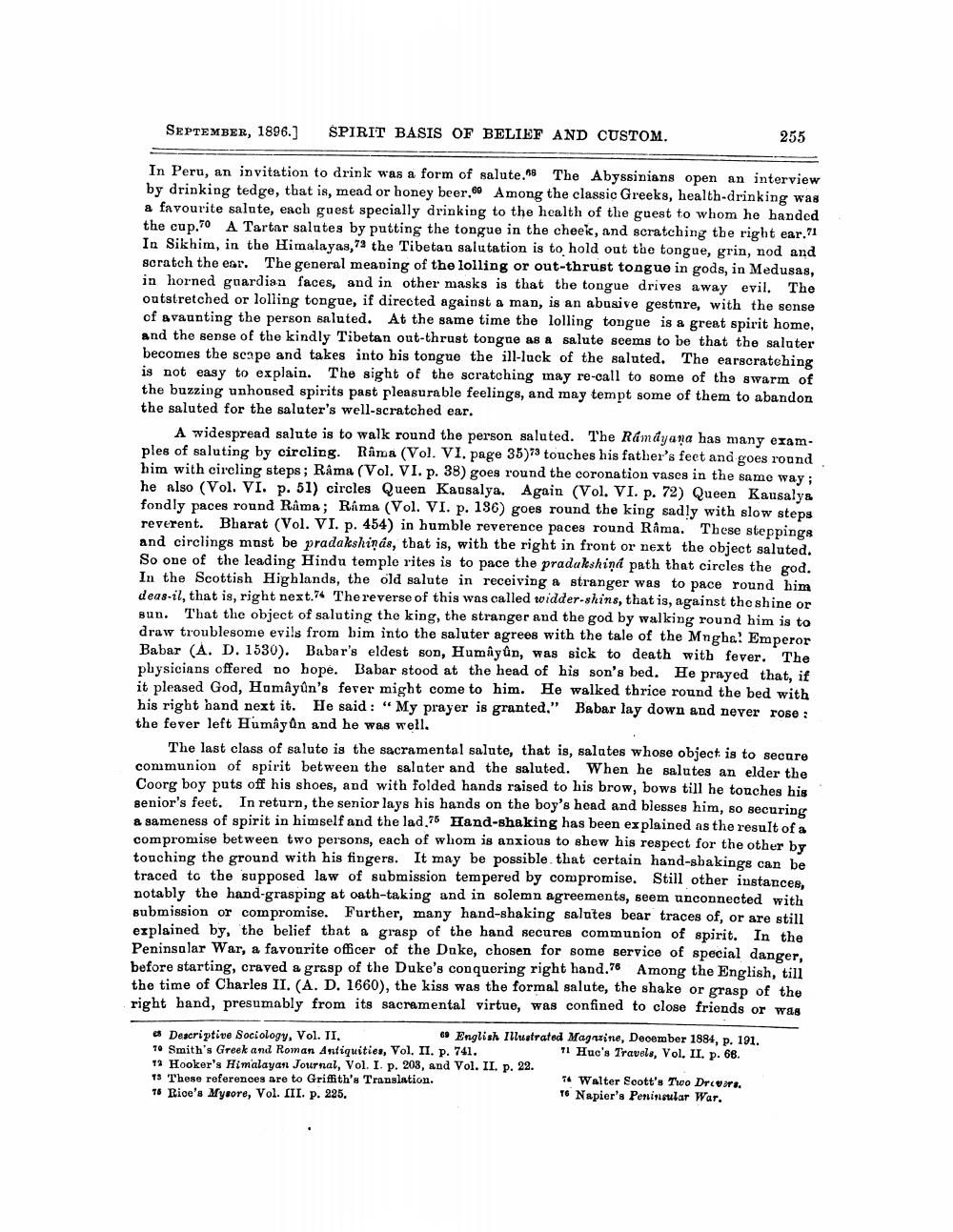________________
SEPTEMBER, 1896.]
SPIRIT BASIS OF BELIEF AND CUSTOM.
In Peru, an invitation to drink was a form of salute. The Abyssinians open an interview by drinking tedge, that is, mead or honey beer. Among the classic Greeks, health-drinking was a favourite salute, each guest specially drinking to the health of the guest to whom he handed the cup.70 A Tartar salutes by putting the tongue in the cheek, and scratching the right ear.71 In Sikhim, in the Himalayas,73 the Tibetan salutation is to hold out the tongue, grin, nod and scratch the ear. The general meaning of the lolling or out-thrust tongue in gods, in Medusas, in horned guardian faces, and in other masks is that the tongue drives away evil. The outstretched or lolling tongue, if directed against a man, is an abusive gesture, with the sense of avaunting the person saluted. At the same time the lolling tongue is a great spirit home, and the sense of the kindly Tibetan out-thrust tongue as a salute seems to be that the saluter becomes the scape and takes into his tongue the ill-luck of the saluted. The earscratching is not easy to explain. The sight of the scratching may re-call to some of the swarm of the buzzing unhoused spirits past pleasurable feelings, and may tempt some of them to abandon the saluted for the saluter's well-scratched ear.
A widespread salute is to walk round the person saluted. The Ramayana has many examples of saluting by circling. Râma (Vol. VI. page 35)73 touches his father's feet and goes round him with circling steps; Râma (Vol. VI. p. 38) goes round the coronation vases in the same way; he also (Vol. VI. p. 51) circles Queen Kausalya. Again (Vol. VI. p. 72) Queen Kausalys fondly paces round Râma; Ráma (Vol. VI. p. 186) goes round the king sadly with slow steps. reverent. Bharat (Vol. VI. p. 454) in humble reverence paces round Rima. These steppings and circlings must be pradakshinás, that is, with the right in front or next the object saluted. So one of the leading Hindu temple rites is to pace the pradakshina path that circles the god. In the Scottish Highlands, the old salute in receiving a stranger was to pace round him deas-il, that is, right next.74 The reverse of this was called widder-shins, that is, against the shine or sun. That the object of saluting the king, the stranger and the god by walking round him is to draw troublesome evils from him into the saluter agrees with the tale of the Mngha! Emperor Babar (A. D. 1530). Babar's eldest son, Humâyûn, was sick to death with fever. The physicians offered no hope. Babar stood at the head of his son's bed. He prayed that, if it pleased God, Hamâyûn's fever might come to him. He walked thrice round the bed with his right hand next it. He said: "My prayer is granted." Babar lay down and never rose : the fever left Humayun and he was well.
The last class of salute is the sacramental salute, that is, salutes whose object is to secure communion of spirit between the salater and the saluted. When he salutes an elder the Coorg boy puts off his shoes, and with folded hands raised to his brow, bows till he touches his senior's feet. In return, the senior lays his hands on the boy's head and blesses him, so securing a sameness of spirit in himself and the lad.75 Hand-shaking has been explained as the result of a compromise between two persons, each of whom is anxious to shew his respect for the other by touching the ground with his fingers. It may be possible that certain hand-shakings can be traced to the supposed law of submission tempered by compromise. Still other instances, notably the hand-grasping at oath-taking and in solemn agreements, seem unconnected with submission or compromise. Further, many hand-shaking salutes bear traces of, or are still explained by, the belief that a grasp of the hand secures communion of spirit. In the Peninsular War, a favourite officer of the Duke, chosen for some service of special danger, before starting, craved a grasp of the Duke's conquering right hand.76 Among the English, till the time of Charles II. (A. D. 1660), the kiss was the formal salute, the shake or grasp of the right hand, presumably from its sacramental virtue, was confined to close friends or was
es Descriptive Sociology, Vol. II.
70 Smith's Greek and Roman Antiquities, Vol. II. p. 741.
12 Hooker's Himalayan Journal, Vol. I. p. 203, and Vol. II. p. 22.
es English Illustrated Magazine, December 1884, p. 191. 71 Huc's Travels, Vol. II. p. 68.
13 These references are to Griffith's Translation. 75 Rice's Mysore, Vol. III. p. 225.
255
74 Walter Scott's Two Drivers. Te Napier's Peninsular War.




